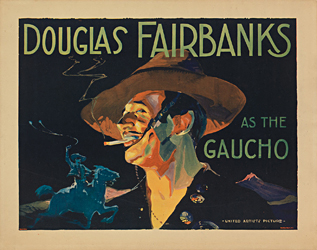The Cinematic Cool of Douglas Fairbanks

Douglas Fairbanks, the dashing actor whose magnetic presence radiated palpably off the silent screen, roared through the 1920s in a swirl of glamour, energy, and charisma as the leading actor of Hollywood. Born in 1883 in Denver, Colorado, Fairbanks, with his interminable energy, bounded from occupation to occupation until he landed on the Broadway stage in New York. After his first hit theatrical run in 1907, Fairbanks headed back west to conquer the new media juggernaut—Hollywood. Tanned and swarthy, Fairbanks created the swashbuckling title roles in The Gaucho (1927), The Black Pirate (1926), The Thief of Bagdad (1924), and the legendary The Mark of Zorro (1920).
He was famous for his stunts that seemingly defied the laws of physical science: vaulting over burros, jumping from rooftop to rooftop, flying over the city of Baghdad on a magic carpet. As Fairbanks’s fans eagerly embraced this image of the handsome rakish scalawag, the actor was proving his business acumen in Hollywood.
In its early years of churning out anonymous pretty faces and uncredited actors, the major Hollywood production studios pocketed the profits from every single film they released. Appalled by the minimal salaries paid to actors starring in pictures and the lack of control Hollywood players exerted over the distribution of their films, Fairbanks and his wife, Mary Pickford, the first of America’s sweethearts; Charlie Chaplin; and director D. W. Griffith left their respective studios and formed United Artists in 1919. Fairbanks was also later honored by becoming the first president of the Academy of Motion Picture Arts and Sciences (which presents the Oscars) in 1927.
An exuberant personality,Fairbanks dominates this poster for his 1927 motion picture, The Gaucho, his last silent film. Fairbanks’s swarthy, grinning face is highlighted by the glow of a campfire, and a cowboy hat is rakishly fixed atop his head. The Argentine mountain range of the Andes rolls behind him, and Fairbanks in miniature rides his rearing horse, waving the bolas, a double-weighted lariat touted as an exotic new piece of weaponry in the film’s press campaign. The frenetic lines of the bolas echo lazily in the trail of smoke that drifts from the cigarette perched in Fairbanks’s mouth. Glamorous and the epitome of early cinematic cool, this image captures Fairbanks at his finest. For more posters see the National Portrait Gallery's exhibition “Ballyhoo! Posters as Portraiture."